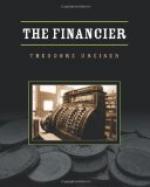Cowperwood started in the note brokerage business with a small office at No. 64 South Third Street, where he very soon had the pleasure of discovering that his former excellent business connections remembered him. He would go to one house, where he suspected ready money might be desirable, and offer to negotiate their notes or any paper they might issue bearing six per cent. interest for a commission and then he would sell the paper for a small commission to some one who would welcome a secure investment. Sometimes his father, sometimes other people, helped him with suggestions as to when and how. Between the two ends he might make four and five per cent. on the total transaction. In the first year he cleared six thousand dollars over and above all expenses. That wasn’t much, but he was augmenting it in another way which he believed would bring great profit in the future.
Before the first street-car line, which was a shambling affair, had been laid on Front Street, the streets of Philadelphia had been crowded with hundreds of springless omnibuses rattling over rough, hard, cobblestones. Now, thanks to the idea of John Stephenson, in New York, the double rail track idea had come, and besides the line on Fifth and Sixth Streets (the cars running out one street and back on another) which had paid splendidly from the start, there were many other lines proposed or under way. The city was as eager to see street-cars replace omnibuses as it was to see railroads replace canals. There was opposition, of course. There always is in such cases. The cry of probable monopoly was raised. Disgruntled and defeated omnibus owners and drivers groaned aloud.
Cowperwood had implicit faith in the future of the street railway. In support of this belief he risked all he could spare on new issues of stock shares in new companies. He wanted to be on the inside wherever possible, always, though this was a little difficult in the matter of the street-railways, he having been so young when they started and not having yet arranged his financial connections to make them count for much. The Fifth and Sixth Street line, which had been but recently started, was paying six hundred dollars a day. A project for a West Philadelphia line (Walnut and Chestnut) was on foot, as were lines to occupy Second and Third Streets, Race and Vine, Spruce and Pine, Green and Coates, Tenth and Eleventh, and so forth. They were engineered and backed by some powerful capitalists who had influence with the State legislature and could, in spite of great public protest, obtain franchises. Charges of corruption were in the air. It was argued that the streets were valuable, and that the companies should pay a road tax of a thousand dollars a mile. Somehow, however, these splendid grants were gotten through, and the public, hearing of the Fifth and Sixth Street line profits, was eager to invest. Cowperwood was one of these, and when the Second and Third Street line was engineered, he invested in that and in the Walnut and Chestnut Street line also. He began to have vague dreams of controlling a line himself some day, but as yet he did not see exactly how it was to be done, since his business was far from being a bonanza.




